AOVs - Arnold for 3ds Max
| Further Reading |
|---|
| See also Output and AOVs in the Arnold User Guide |
AOVs (Arbitrary Output Variables) provide a way to render any arbitrary shading network component into different images. For example, an artist might find it convenient to separate direct and indirect lighting contributions and later recombine them during compositing. Arnold provides built-in AOVs for outputting depth, position, and motion vectors.
- MAXtoA supports Cryptomatte AOV shaders.
- An introduction to AOVs for compositing tutorial can be found here.
- Multichannel EXRs are possible using All In One File (RGBA).
- Tutorials using AOVs can be found here.
- AOVs do not have any Exposure Control (tone mapping) applied to them. However, the beauty pass specified in the Common tab will, and this appears in the Rendered Frame Window. Unlike Render Elements, AOVs are saved by Arnold and do not show up in the window after rendering.
- Using closures as AOVs is not currently supported.
AOVs are similar in concept to Render Elements, in that they separate out components of the rendered image as it is produced, and send it either to a separate output file and/or as a channel in an EXR. Arnold supports output types and features not found in Render Elements.
Video tutorials about using AOVs in MAXtoA can be found here.
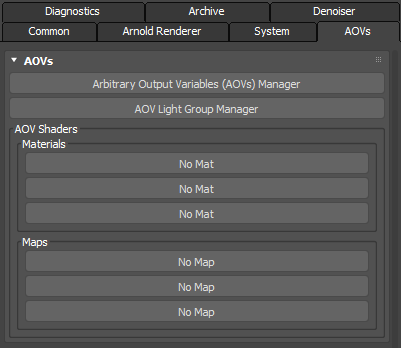
Arbitrary Output Variables (AOVs) Manager and AOV Light Group Manager (via AOVs tab)
Arbitrary Output Variables window
The Arbitrary Output Variables (AOV) Manager lets you drag AOVs from the AOV List to AOV files. (topicid=arnold_for_3ds_max_ax_render_setup_ax_light_group_manager_html) window.
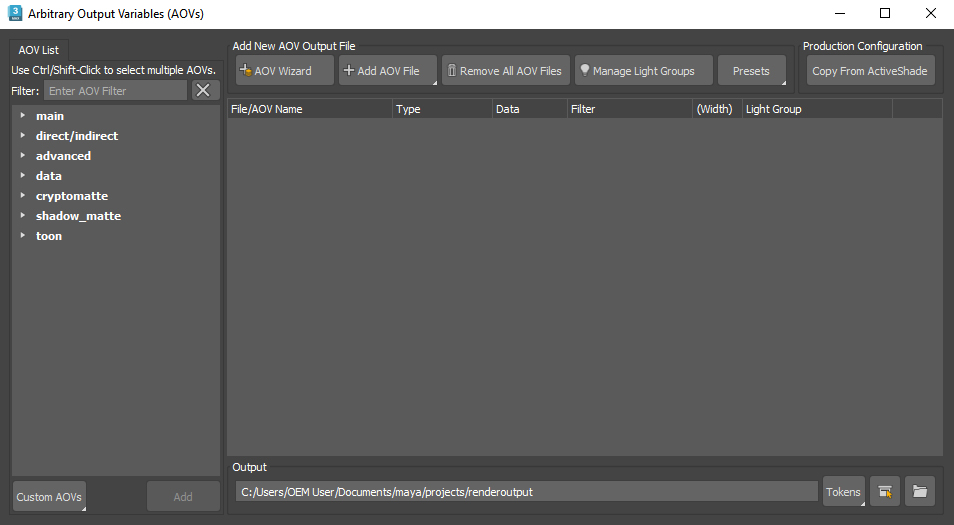
The main view shows an AOV list to add Drivers and AOVs (drag and drop).
AOV Wizard
The AOV wizard is where you can Add Drivers and AOVs (also available in the + Add AOV File menu).
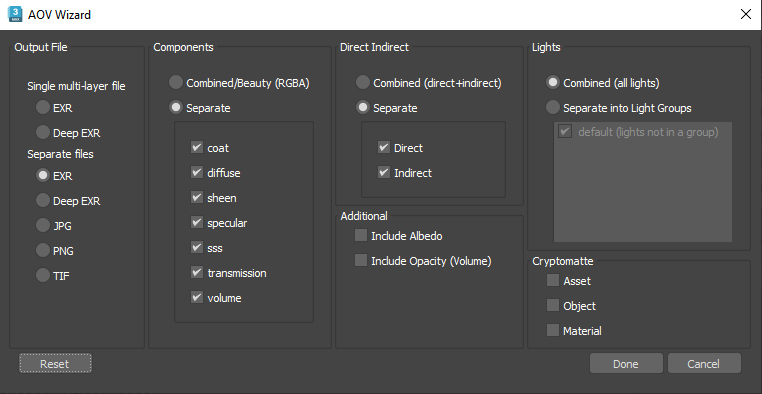
Output File
Choose between a single multi-layer file or separate files (default).
Components
Choose between separate individual component AOVS (default) or a combined/Beauty (RGBA) AOV.
Direct/Indirect
Choose to split separate direct and indirect AOVs or have them combined (direct+indirect).
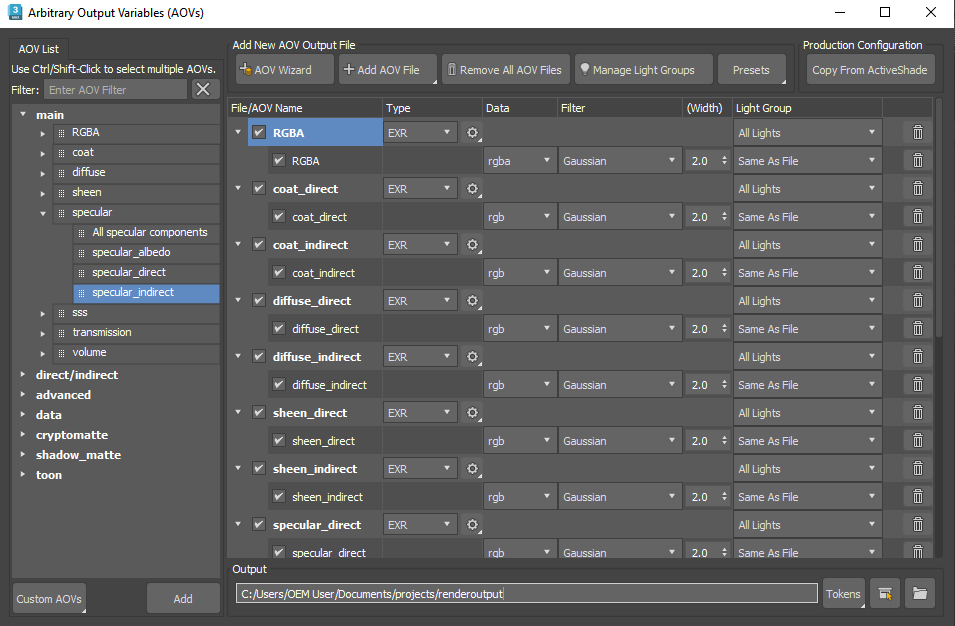
Separate direct/indirect AOVs (combined disabled).
Lights
Choose to have all lights combined or separate into Light Groups.
Add New AOV Output File
MAXtoA takes a file-centric approach. You start defining your AOVs by first specifying the file type (+ADD AOV File) that you want to produce and then the AOVs you want to save to that file type.
AOV List
+ ADD AOV File
Select this button first to choose the AOV Output File.
You can drag & drop AOVs that you want to use for your render from the AOV list on the left onto the main window on the right. You can also add more AOVs to the same group if you drag and drop on the existing AOV (see below).

Drag & drop AOVS from the AOV list into the main area where you can adjust the type, driver, and filter of the chosen AOVs.
File/AOV Name
The filename of the AOV. The names of the output files can be renamed here. Multiple AOVs can be dragged onto a single AOVs group. This can be useful for light groups where you might want a diffuse AOV in both a red and blue light group.
Type
Here you can choose the file type (driver) format which you want to output from MAXtoA.
Data
The type of data to be written in the AOV - rgba, float, vector, etc. Arnold will normally specify a default type for each AOV, so you don't have to explicitly set this.
Filter
The AOVs use the image pixel filter defined in the Arnold Renderer tab. Gaussian is the default.
Light Group
Choose between:
Same as File: (only available for AOVS) - The AOV will use the AOV Light Group setting defined at the file level. Same As File, All lights or default.
All lights: The AOV(s) will be rendered using all lights, regardless of AOV light group assignation.
Default: The AOV(s) will be rendered using the scene lights that are not assigned to a light group (or are assigned to the "default" light group).
Remove All AOV Files
Choose to remove all AOV files from the main pane.
Manage Light Groups
Opens the light group manager window.
Presets
Choose to load/save different AOV presets.
Custom AOVs
You can define custom AOVs in the scene via the Add Custom AOV button if you want to render a custom effect that is not available from the existing AOV list. This custom AOV can be used with any compositing software, such as Nuke. You can write the output of a shader in a custom AOV via an aov_write shader.
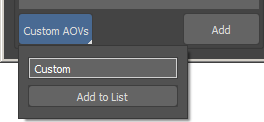
A list of shaders can be defined that will be evaluated after the regular surface shader. With this, it's possible to add shaders to set specific AOVs without modifying the original shader tree. Shaders intended for this purpose should add a boolean metadata named aov_shader on the node itself, as a user-interface hint. If options.atmosphere or options.background are set, these global AOV shaders will also be run for atmosphere and background contexts.
Output Path Tokens
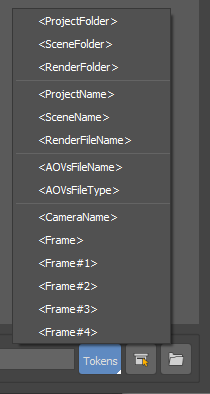
Tokens (select a token), Select Output Folder and Open Output Folder
Tokens are used to generate dynamic AOV output paths. You can use tokens to define both the folder structure and the output filenames. If the generated path does not end with a valid filename extension (EXR, PNG), the default name and extension of the AOV file will be added automatically.
If the output expression does not end with a valid file extension, the expression is assumed to be a path. The current valid end of expressions (extensions) are (case insensitive):.exr, .deepexr, .jpg, .jpeg, .tiff, .png, and .<AOVsFileType>
If the expression resolves as a path, "/
Tokens are case insensitive.
uses zero padding, 4 digits.Examples:
- Output paths
- C:/Program Files/Autodesk/3ds Max 2021/renderoutput
- C:/_/out/
- Output files
- C:/Program Files/Autodesk/3ds Max 2021/
. (current default - single frame) - C:/Program Files/Autodesk/3ds Max 2021/
. (current default - frame sequence) - C:/Program Files/Autodesk/3ds Max 2021/
_ . (old aov interface behavior for a sequence) - C:/_//
.png
